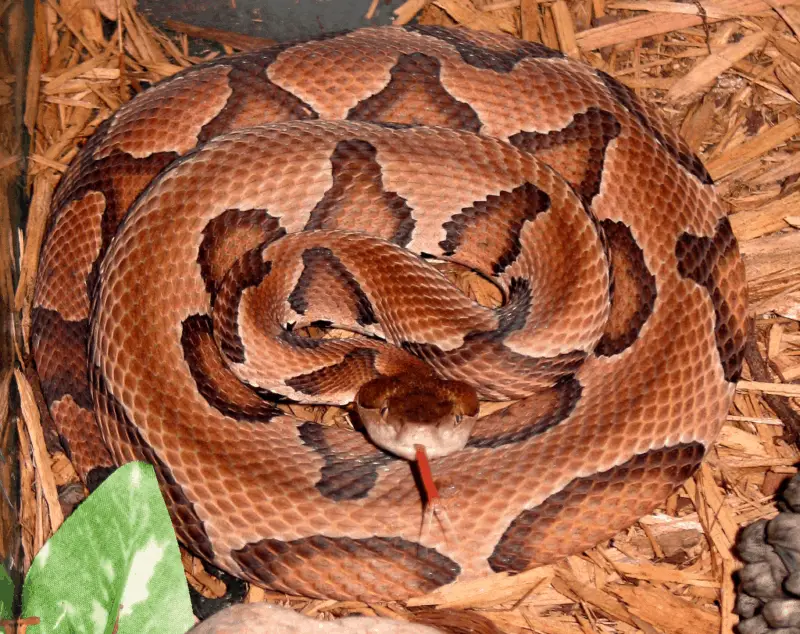There are two species of venomous snakes in New Jersey. Both are pit vipers. These are the Timber Rattlesnake and Eastern Copperhead. Each of these snakes poses potential risks. An average of 25 people are bitten by New Jersey’s venomous snakes each year. Understanding their appearance, behavior, and habitats can help you navigate the outdoors safely.
Both snakes are on the endangered species list in New Jersey due to their rarity. This is unfortunate because, despite their fearsome reputation, pit vipers play an important role in the natural world by controlling rodent populations and disease-carrying pests such as fleas and ticks.
In this comprehensive guide, we’ll tell you where Timber Rattlesnakes and Eastern Copperheads can still be found in New Jersey. We’ll also tell you how to identify and co-exist with these snakes as safely as possible in New Jersey’s outdoors.
Pit Vipers: The Venomous Masters of Infrared Detection
Rattlesnakes, Copperheads, and Cottonmouths are North American members of the Crotalinae subfamily of the Viperidae family of venomous snakes. They are also referred to as pit vipers.
Since both of New Jersey’s venomous snakes are pit vipers, let’s take a closer look at some of their characteristics.
What Makes Pit Vipers Unique?
- Infrared-Sensing Pits:
A defining feature of pit vipers is the deep facial pit between their nostril and the eye on each side of their head. These specialized infrared-detecting organs allow pit vipers to sense heat emitted by prey. This adaptation enables them to:- Detect body heat from up to 1 meter away.
- Strike prey with pinpoint accuracy, even in complete darkness.
- Triangular Heads and Vertical Pupils:
- Head Shape: Pit vipers are recognized by their distinct triangular-shaped heads, which house their venom glands.
- Eyes: They have vertical elliptical-shaped pupils.
- Venomous Fangs:
Pit vipers have hollow fangs connected to venom glands. These fangs fold back against the roof of their mouth when not in use.
Ecological Importance
Pit vipers serve as a check to rodent populations. Despite their fearsome reputation, these snakes are vital to the health of many habitats.
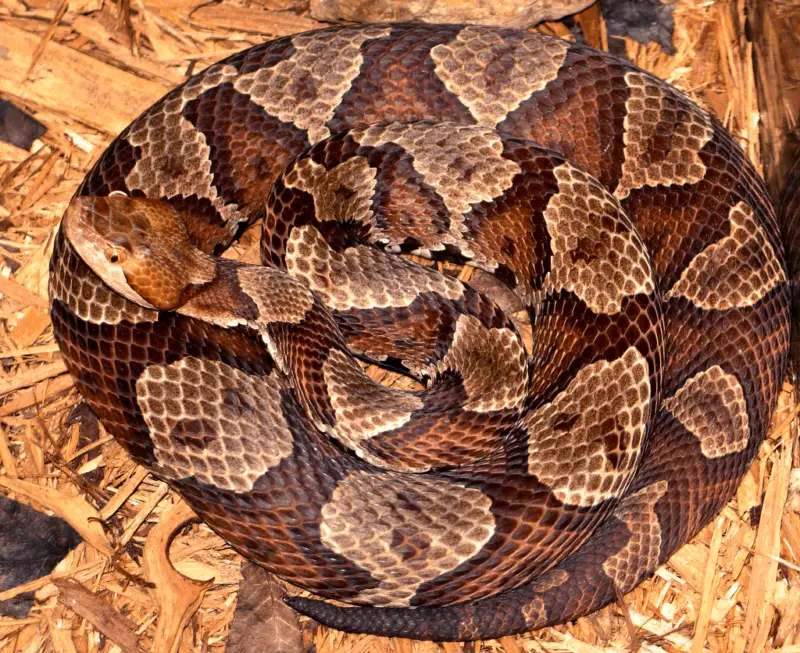
Eastern Copperhead (Agkistrodon contortrix)
The Eastern Copperhead is a pit viper native to the eastern United States.
What Do Eastern Copperheads Look Like?
| Size | *Adults range from 20 to 37 inches (50 to 95 cm) in length. |
| Coloration | *Reddish-tan to grayish-tan bodies. *Overlaid with dark brown, hourglass-shaped markings. *Heads are dark coppery brown, giving them the name “Copperhead.” |
| Body Shape | *Stout and heavy-bodied snakes. *As with all pitvipers, their heads are triangular and appear oversized in relation to their necks. |
| Conservation Status | *Species of Special Concern in New Jersey |
Taxonomy of Nebraska’s Eastern Copperhead Snakes
Copperhead snakes are now recognized as a single species: the Eastern Copperhead (Agkistrodon contortrix).
In the past, these snakes were classified into different subspecies, including the Northern Copperhead, Southern Copperhead, and Osage Copperhead. However, recent DNA studies revealed minimal genetic differences between them. As a result, these subspecies were combined into a single taxonomic group under the Eastern Copperhead name.
Where Do Eastern Copperhead Snakes Live In New Jersey?
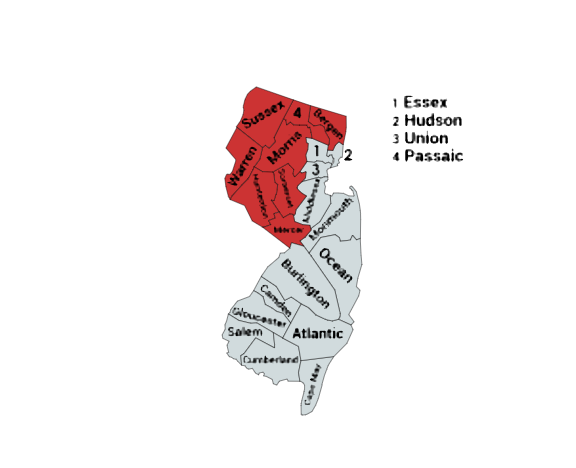
Eastern Copperheads are scattered throughout the northern part of the state. This is primarily in Warren, Hunterdon, Passaic, and Sussex County.
They are found in the Sourland Mountain region. This lies in Somerset, Mercer, and Hunterdon counties. They also live in western Bergen County.
Watch for these snakes in wooded areas such as river bottoms. They prefer areas where the leaf and plant debris provide cover for them to hide. This could also, at times, include wooded suburbs.
Eastern Copperhead Behavior
Copperheads are dangerous because they use camouflage as their number one defense mechanism. In other words, these snakes choose to lie perfectly still rather than flee most of the time. Their camouflage helps them blend in with leaf litter and other ground debris.
When they feel threatened, they occasionally mimic the tail vibration of a rattlesnake. But, in most cases, they choose to lie perfectly still.
Most copperhead bites on humans occur when the person steps on or near the snake.
What Do Eastern Copperheads Eat?
Copperheads prey on a variety of species. Their menu includes small rodents, amphibians, birds, snakes, lizards, and insects.
How Dangerous are Copperheads?
A Copperhead can bite and inject venom when they are newly born. Like most pit vipers, they have hemotoxic venom.
Most copperhead bites are not life-threatening. On the other hand, any bite from this snake is a medical emergency and should be treated as such. If a copperhead bite victim gets medical help fast, they have a better chance of a positive outcome.
Copperhead bites can cause intense pain, shock, and swelling. Their bites also have the potential to cause blood in urine, tissue damage, and kidney failure.
An interesting study has found that Copperhead venom contains a protein called contortrostatin. Contortrostatin has been found to stop the growth of cancer cells in mice.
Rattlesnakes in New Jersey
Rattlesnakes are pit vipers. See the description of pit vipers above.
What New Jersey’s rattlesnakes have in common with most other rattlesnake species is their rattle.
- Most rattlesnakes have a rattle at the end of their tail, comprised of hollow, loosely interlocked keratinous scales.
- Normally, a rattlesnake adds a new segment to its rattle each time it sheds its skin.
- An agitated rattlesnake rapidly vibrates its tail, causing the segments of its rattle to vibrate together, creating a rattling or buzzing sound.
- Not all rattlesnakes rattle before they strike. Sometimes, they lose their rattles due to injury, and sometimes, they choose not to rattle.
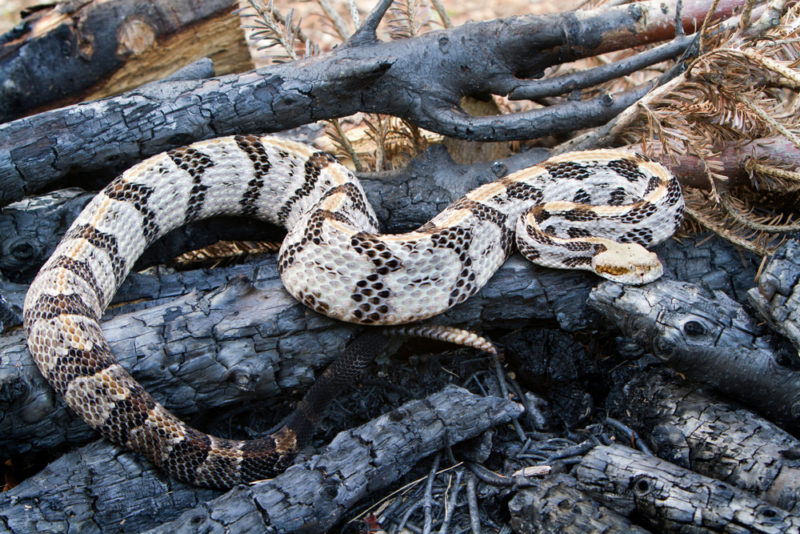
Timber Rattlesnake (Crotalus horridus)
Timber Rattler and Canebrake Rattlesnake are both common names for the Timber Rattlesnake. Generally, in higher-elevation habitats, they are called Timber Rattlesnakes. On the coastal plain, though, they’re called Canebrake Rattlesnakes.
What Do Timber Rattlesnakes Look Like?
| Size | *Average length: 36 to 60 inches (0.91 to 1.52 m). *Rare cases reported: Up to 7 feet (2.13 m). |
| Coloration | *General base color: Yellowish-brown to grey-brown. *Chevron pattern: Dark brown to black chevrons on their back and sides against a lighter base color. *Back stripe: Rusty to reddish stripe running down their back. *Tail color: Dark brown or black. |
| Melanistic Variation | *Some timber rattlesnakes exhibit a dark, melanistic color morph. *These snakes can appear almost entirely black. *The tail is darker than the rest of the body in this morph. |
| Behaviors | *These snakes are excellent climbers. In fact, timber rattlers have been found in trees at heights of more than 80 feet. *The experts have proven that timber rattlesnakes help control Lyme disease. This is because as they consume rodents, they’re also consuming ticks. A timber rattler will consume 2,500 to 4,500 ticks per year, depending on the location. |
| Conservation status | *They are endangered in New Jersey. |
Snakes That Look Like Timber Rattlesnakes
The Northern Water Snake and the Eastern Milk Snake have something in common. They both are Garden State snake species that are sometimes confused with rattlesnakes. Both snakes have varying color morphs. Certain individuals look a bit like rattlesnakes. Milk snakes even imitate the tail rattle of a rattlesnake sometimes. The effect can be pretty convincing if they vibrate their tails in dry leaves.
Where Do Timber Rattlesnakes Live in New Jersey?
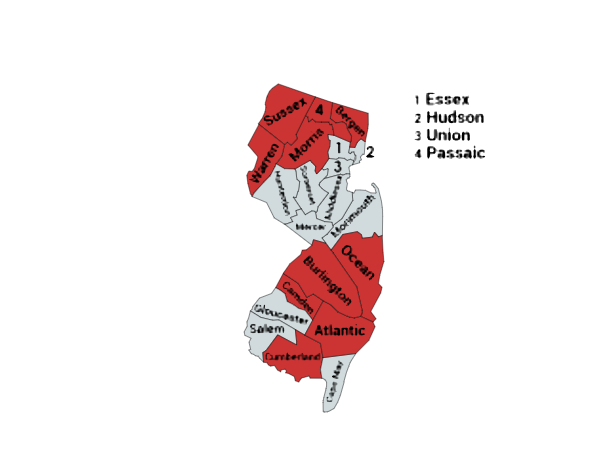
The Timber rattlesnake resides in three specific regions in New Jersey.
In the north, they live on Kittatinny Ridge. They also live in the northernmost portion of the highlands. This includes the mountainous areas of Warren, Sussex, Passaic, Morris, and Bergen counties.
In southern New Jersey, they inhabit the Pinelands region. They’re also in adjacent parts of Cumberland, Ocean, Burlington, and Atlantic counties.
The Timber Rattlesnake lives in various habitats. These include deciduous forests, pine forests, swamps, farm fields, and river floodplains. These snakes are marvelous climbers and have been found in trees at heights of more than 80 feet.
What Do Timber Rattlesnakes Eat?
Timber rattlers prey on small mammals such as mice, rats, squirrels, chipmunks, and bats. They also eat small birds, other reptiles, and amphibians.
What Eats Timber Rattlesnakes?
There are several potential predators of Timber Rattlesnakes in New Jersey. These include Eastern Milksnakes, Eastern Black Racers, birds of prey, skunks, and bobcats.
How Dangerous Are Timber Rattlesnakes?
Timber Rattlesnakes are among the most dangerous snakes in North America. This is due to their long fangs and high venom yield. 1% to 10% of untreated Timber Rattlesnake bites result in a fatality.
Fortunately, 40% to 60% of the time, they produce dry bites. In other words, although their fangs penetrate the body, they do not inject any venom.
These snakes produce hemotoxic venom. Timber Rattlesnake bites sometimes cause serious complications. These include shock, seizures, coma, internal bleeding, and deep tissue damage.
Why Are Timber Rattlesnakes Endangered In New Jersey?
Timber rattlers are an endangered species in New Jersey. In this section, we’ll review some of the problems that the species faces in New Jersey.
Human encroachment in their historic range has a huge impact on their populations. As Timber Rattlesnake populations shrink, the diminished genetic base promulgates inbreeding depression. In turn, this leaves the successive generations less genetically fit for survival.
Timber Rattlesnakes don’t deal with alterations to their environment very well. They tend to use the same basking and denning sites through multiple generations. When a new housing development appears over one of these areas, the snakes are no longer welcome.
Roads also make things quite a bit harder for the average timber rattler. It’s obvious that snakes are sometimes killed on roadways. But paved roads also serve as barriers between timber rattlesnake populations. This inhibits gene flow between populations and promotes inbreeding depression.
Paved roads in New Jersey’s Pine Barrens are barriers between Timber Rattlesnake populations. Arcadia University and College of New Jersey research reveals this to be the case.
SFD, or snake fungal disease, is also present in New Jersey Timber Rattlesnakes. This is a potentially fatal disease. It spreads through snakes and reptiles through physical contact. It has potentially huge detrimental possibilities for Timber Rattlesnake populations.
New Jersey’s Venomous Snakes in Winter: Insights into Brumation
During winter, New Jersey’s snakes, like all reptiles, enter a dormant state called brumation—a hibernation-like period. Because snakes are ectothermic (cold-blooded) and cannot regulate their body temperature internally, they slow their metabolism and become inactive during the colder months.
Brumation Habits
- Solo vs. Communal Brumation: Some snakes brumate alone, while others gather in communal dens. For example, Eastern Copperheads and Timber Rattlesnakes often share dens, which may house up to 60 snakes.
- Mixed-Species Dens: Interestingly, it’s not uncommon to find non-venomous snakes, such as Black Rat Snakes, sheltering alongside venomous snakes.
Regional Variations
- Snakes may only seek shelter in warmer areas on the coldest days.
Where Snakes Spend Winter
Snakes seek out protected spots to brumate, such as:
- Rock crevices
- Hollow logs
- Fissures on rocky hillsides
They often choose south-facing slopes because these areas receive more sunlight, providing additional warmth during winter.
This natural adaptation allows New Jersey’s venomous snakes to survive the winter and re-emerge when temperatures rise.
Avoiding Snake Bite
Snakes, including venomous ones, commonly rely on camouflage to hide from potential threats. They often remain perfectly still to avoid detection. If you’re walking in the woods and unknowingly get too close, a snake might not move, hoping you’ll pass by. Many bites happen when someone accidentally steps on or close to the snake. To stay safe in snake habitats, always watch where you step and where you place your hands.
Another common cause of snake bite is attempts to capture or kill a snake. Remember, venomous snakes can strike instantly, delivering a potentially life-threatening bite. The safest approach is to keep a safe distance and leave them alone.
Dressing for Snake Country
- High-top leather boots and long pants are both wise ideas.
- Also, wear loose-fitting denim. If there’s a gap before the snake’s fangs touch your skin, your chances of being envenomated are lower.
- In the absence of high-top leather boots, some people wear snake gaiters.
Symptoms of Venomous Snake Bites
Some of the symptoms you may experience when a venomous snake bites you include:
- Discoloration in the area of the bite.
- Swelling in the area of the bite.
- Loss of muscle coordination.
- Tingling sensation in the area of the bite.
- Feeling nauseous.
- Having an elevated heart rate.
What Should You Do if You Are Bitten?
If you or someone you are with has suffered a venomous snakebite, time is of the essence. Because timely administration of antivenom creates a greater chance of a positive outcome. In other words, it is important to seek immediate medical attention.
Do not attempt to kill the snake for identification purposes. This gives the snake a chance to bite you again. Also, consider that severed snakeheads can still bite and envenomate and often do. If you have a phone, take a photo of the snake. Otherwise, get started on your way to the nearest hospital.
First Aid for Snake Bite Victims
- The best thing you can do is remain calm and limit your movements. Do not run. If you must hike back to a vehicle, do it calmly and deliberately. Put as little stress on your heart as possible.
- Keep the area of the snake bite below the heart level and never above the heart level. Keeping the bite below the heart level will reduce the venom’s flow. However, holding the bite above your heart level will increase the venom’s flow.
- Remove all constricting items such as bracelets, watches, or rings before swelling occurs.
- Remember that using a cold compress on a venomous snake bite is not advisable. The cold may cause the local blood vessels to constrict and spread the venom faster.
- You can wash the affected area like any other wound with soap and water.
- You may cover the bite area with a moist dressing to reduce the swelling.
- Get prompt medical treatment. Call the hospital to tell them a venomous snake has bitten you. So they can have antivenom ready to give you when you arrive.
- A person whom a venomous snake has bitten may go into shock. If this happens, lay them flat and cover them with a blanket.
Conclusion
New Jersey’s two venomous snakes, the Eastern Copperhead and the Timber Rattlesnake, play vital ecological roles. They contribute to controlling rodent populations and even reducing disease transmission. This underscores their importance to local ecosystems.
As both species are endangered in the state, their preservation requires a balanced understanding of their habitats, behaviors, and conservation needs.
Despite their potentially dangerous bites, these snakes are more interested in avoiding humans than attacking them. However, human/snake conflicts do take place. A couple dozen people are bitten by venomous snakes in New Jersey each year.
We can safely coexist with these remarkable reptiles by respecting their space, learning to identify them, and taking precautions in snake-prone areas. Let their presence serve as a reminder of New Jersey’s diverse and intricate natural world, worthy of protection and admiration.
Recent Posts
The only venomous snakes in Washington State are Northern Pacific Rattlesnakes. The Northern Pacific Rattlesnake (Crotalus oreganus oreganus) is a sub-species of the Western Rattlesnake. Anyone...
Skunks are not classified as true hibernators. But they go into a state of torpor when the weather gets cold. Skunks are light sleep hibernators, along with opossums, bears, and raccoons. ...

